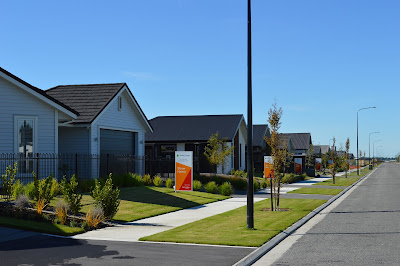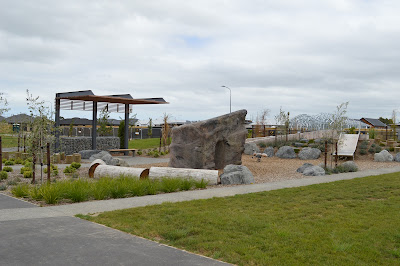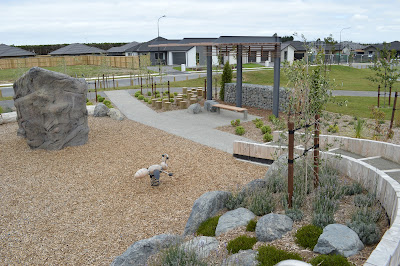
To build or not to build. That's the question many of us ask ourselves when trying to get out of the rental noose around our necks.

With no job offers and no income coming in I was obliged to sell my aging house in Pakuranga, Auckland and look for somewhere more affordable. Flat land? Less than $200,000 for a decent section with services? Near all the usual metropolitan services for aging folks and those who still need a job? Those criteria narrow New Zealand down quite a bit.
Hello Rolleston; not too far from Christchurch but far enough away in case of more earthquakes. Too far from the sea to be threatened by tsunamis. Limited snow, can be a bit windy at times.
I spent a lot of time meeting real estate agents and viewing existing homes: modern and souless with apalling excuses for gardens. I might have chosen one before I went to France but I've come back different, or maybe I'm more ME. I don't fit emotionally into a 'normal, modern' kiwi house and I really need MY kind of intensive garden. The later is rare to find these days. All up, I was bored and despairing with what was on offer. To get anything like what I wanted I would have to build and still make a lot of compromises. I knew it was not going to be an easy option and it was going to be $100,000 more expensive than an existing bog-standard home. But it could be unique.

I found a section in December 2017 during a brief trip to Rolleston. I sat down with the real estate agent to see what was available. Most sections had gone in the subdivision I was looking for but I was assured a section down a right of way was as good as any other and that title for the first stage would be released the following month. My section should be available for building in April even though the official word was July. "July is too late." I said. "No problem", he said, the good weather had them well on track for me to get title in April.
Just before Christmas he put a LOT of pressure on me to sign the contract. I had already received a copy of the contract and sent that on to my expensive Auckland lawyer. She had concerns over the vagueness in many areas and the lack of transparency concerning ALL the partners selling off the subdivision. I had concerns about how much money I might be up for to pay for the right of way and vehicle crossing. The developer was also charging $400 to approve my building plan. And then there was the $2500 bond in case of damage. Costs after costs.

The estate agent started getting aggressive with me and accusing my lawyer of stalling and ripping me off financially just to drag out the process and cost me more money than necessary. "I've had enough of this," raged the agent. I told him to calm down, I was the client, the one with the money and my lawyer was doing her job protecting me; necessary since the developers' lawyer hadn't even seen a copy of the contract written up by the agent. Christmas came and went and I made preparations to move from Auckland to Rolleston; stressful after an international move only 6 weeks earlier.
Down in Rolleston I checked out the subdivision containing my section. It was a dust bowl, a physical mess and little progress had been made. There was NO WAY the estate agent had been honest about title. I hate dishonesty and agression so I pulled the plug on the deal. It had cost me $2400 because the contract had so many holes in it my lawyer had been obliged to put in extra effort.. An expensive mistake but perhaps it would have been worse if I had persisted.

I found a more professional developer in another subdivision who was releasing the last of its stages. Timing is tricky with subdivisions. They take a long time to develop, depend on suppliers and the weather and finance. Getting title means you have to pay the balance of the section cost so you can then build on it. Prior to that you pay a deposit to hold it, usually 10%. This developer was quite relaxed about giving my lawyer and me extra time to feel comfortable with my decision before paying the deposit. Hughes Development is completing their major subdivision at Faringdon, Rolleston. It's massive with 24 stages and hundreds of homes. My section is in stage 22 and I'm hoping for title any day, even though I'm not yet ready to build because I need specific documentation for developer approval before I even submit my plans to Selwyn District Council.

Faringdon is a nicely done subdivision with recreational areas and facilities and VERY strict covenants. If you are building take heed of the covenants. These are the restrictions the developer puts on your building design, exterior colour scheme, landscaping, fencing, indeed anything you want to do that can be seen from the street and what activities you can do on your section. It's a pain in the butt and slows the whole documentation process down.


Unfortunately for me I have an easment running across one side of my section. I am not allowed to build any structures on the easement so that is quite restrictive in positioning my house. Along one side of stage 22 is the new Faringdon underground sewer. Chances are there won't be any problems in my lifetime but if there were they have the right to come onto my property and dig up my garden, destroying plants and trees to get at the problem down below. My lawyer said easements are common and aren't worth worrying about as it's rare that it causes a problem. Still, it did give me pause for thought. There are so many issues when building from the minute the idea of building a French-inspired home pops into one's mind.
Right now the pegs are in, the grass has germinated, the road is finished and the street lights are up, the deposit is paid, I'm trying to get my 'ducks in a row' for developer approval asap.
Next post: what's involved in getting developer approval and what hoops do you go through getting to the stage of signing a building contract.
Section tips in a subdivision:
- Get a Land Information Memorandum from the council to see what condition the land is in, if there have been hazardous substances. The developer may provide one free on their website. Otherwise you'll pay at lease a couple of hundred dollars.
- Check the developer covenants. they are there to protect your investment but can be quite restrictive in an urban environment.
- Check out homes in the area and see if people look after their properties
- What is the path of the sun? Will your preferred plan sit correctly on the section?
- Is your section on the best side of the road for sun? Many have the sun heating the garage instead of the living areas. Take care with this one as the rest of the house will be cold.
- Is there a bus service and what future developments will arise nearby? Talk to the planning section of your council.
- How long do you expect to be in this house/area - this will determine what you need nearby.
- Have you got fast broadband installed in the subdivision?
- Climate? Wind? Possible natural disasters?








0 comments:
Post a Comment
I welcome your comments, contributions and feedback.